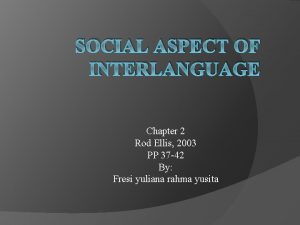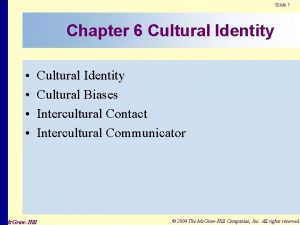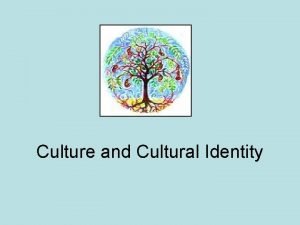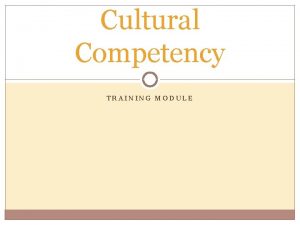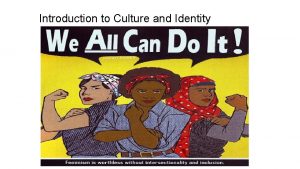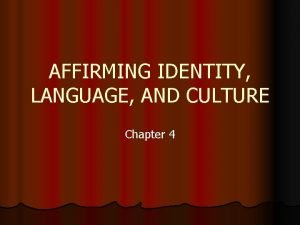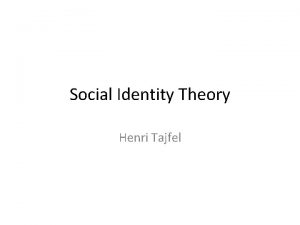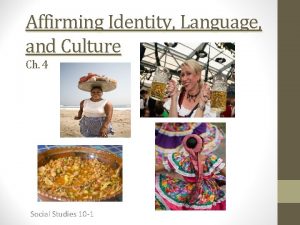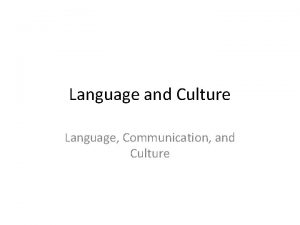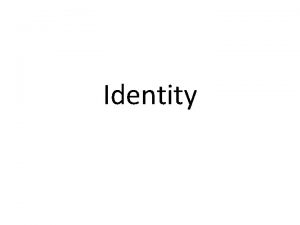Social Identity Rules of Culture Language Written and



















- Slides: 19

Social Identity

Rules of Culture • Language – Written and body movement/gestures • Italians & Jews embellish speech with hand movements – Larger radius Italians • Smile is universal – When do they differ? • When is a smile appropriate? – US smiles more: often seen as a mask – Japanese smile to hide other emotions that are considered incorrect in public (anger, embarrassment)

Hall & Hall, 1990 • Method: Survey • Participants: German and American business men • Conclusion – American views of German business men • Germans smile less Seen as cold and aloof – German views of American business men • American smile a lot Hide their real feeling under a mask of a smile

High & Low Context Cultures • Differ in how much attention is given to the context of a conversation • High-context cultures (Japan & Middle East) – Close attention to nonverbal communication – Assume a shared context (common history and attitudes) – Example: • Too direct “No, I can’t do that’ vs. “That is difficult”

• Low-Context Cultures (Germany & Most of US) – Do not take shared context for granted – Emphasize direct verbal communication • Triandis, 1994 – Verbal language “If you do not move out of Kuwait we will attack you” – Body language moderate and polite – Result • Aziz from Iraq reported to Saddam Hussein that he was ”not at all angry. The Americans are just talking, and they will not attack”

Person vs. Social Identity • Personal Identity – Sense of who one is • • Individual traits & unique history Social Identity Theory – Nationality, ethnicity, religion, gender & social roles • Why is Social Identity Important? – Self-Esteem 1. Need to be included in a larger, collective group 2. Need to feel differentiated from others

4 Elements of Social Identity • Categorization: We often put others (and ourselves) into categories. – Labeling someone a Muslim, a Turk, a Gimp or a soccer player are ways of saying other things about these people. • Identification: We also associate with certain groups (our in-groups) – which serves to bolster our self-esteem. • Comparison: We compare our groups with other groups – seeing a favorable bias toward the group to which we belong. • Psychological/Positive Distinctiveness: We desire our identity to be both distinct from and positively compared with other groups.

Breakwell (1978) • Method: Survey • AIM/Hypothesis: study social identity of soccer fans • Two groups – went to most games – did not go to games. • Results – Those who did not go to games were the most vehement about their loyalty • showed most in-group bias • Why? – presumably as they had a greater need to prove themselves as fans.

More than one social identity? • YES • Some face the dilemma of balancing ethnic identity and acculturation – Ethnic identity • Close identification with own racial, religious or ethnic group – Acculturation • Identifying with and being a part of the dominate culture

Results of Dilemma 1. Bicultural • Strong ties to ethnicity and large culture • “I am proud of both my ethnicity, but I identify just as much with my country” 2. Assimilation • Weak feelings of ethnicity, but a strong sense of acculturation • “I’m an American, period. ” 3. Ethnic separatist • Strong ethnicity but weak feelings of acculturation • “My ethnicity comes first; if I join the mainstream, I’m betraying my origins” 4. Marginal • Connected to neither their ethnicity nor their dominant culture • ‘I’m an individual and don’t identify with any group” or “I don’t belong anywhere’


ETHNIC IDENTITY ACCULTURATION STRONG WEAK STRONG Bicultural Assimilated WEAK Separatist Marginal

What’s In A Name? • Definitely an issue in the US – Many different cultures – Names imposed on them by the majority • Can’t agree on a group label – Negro, Black, Colored People, African. American or Afro-American – Native American, American Indian – Asian Americans (All Asians? ) – White Anglo-Saxon Protestants, European American

Here’s a page from the 1906 schoolbook New Complete Geography showing a number of various “races” and what they look like. Social Science view today One Race, the human race

Social Identity Theory • Value and emotional significance attached to a group 1. Strive to maintain a positive self-concept AND social identity 2. Social comparison • Make comparisons between groups to establish, maintain and defend positive in-group distinctiveness 3. Intergroup discrimination • Uphold positive social identity

Tajfel, 1970 • Aim – Investigate whether boys placed in random groups would display in-group favoritism and intergroup discrimination • Participants: 64 British boys (14 -15) – Knew each other before experiment • Procedure (2) – estimate the # of dots – Artistic preference • Only aware if they belonged to the same/different group • DV: allocate Money

• Results – Allocated more money to own group (in-group) • Implications – In-group favoritism (SIT) is easily created and maintained • Evaluation – Strengths • Shows minimal group dynamics (random allocation of groups) – Limitations • Artificial • Did the boys view it as a game? If so, they are more competitive • Follow-up research – Howarth, 2002

Howarth, 2002 • AIM: show positive social identity • Procedure: How do girls from Brixton define themselves • Results – Positive view – Out-group view of Brixton negative view of being from Brixton

Evaluation of SIT • Strengths • Assumes that intergroup conflict is not required for discrimination to occur – Supported by research – Explains “positive distinctiveness” – Maximize out-group differences • Applicable to – Ethnocentrism, in-group favoritism, conformity to ingroup norms, stereotyping • Limitations • Criticized for being artificial – Experiments are not real life • In-group favoritism cannot explain violent behavior towards out-group • SIT does not explain how social constraints (poverty - plays a bigger role in behavior than social identity
 A.backtoschool
A.backtoschool Social aspects of interlanguage
Social aspects of interlanguage Stylistic continuum
Stylistic continuum Non material culture examples
Non material culture examples Continuous culture and batch culture
Continuous culture and batch culture Difference between american and indian culture
Difference between american and indian culture Uses of selenite f broth
Uses of selenite f broth Folk culture and popular culture venn diagram
Folk culture and popular culture venn diagram Folk culture and popular culture venn diagram
Folk culture and popular culture venn diagram Stab and stroke culture
Stab and stroke culture Folk culture and popular culture venn diagram
Folk culture and popular culture venn diagram Stab culture and stroke culture
Stab culture and stroke culture Carpet culture method
Carpet culture method Surface culture deep culture and esol
Surface culture deep culture and esol Why is culture identity important
Why is culture identity important Levels of identity
Levels of identity Why is culture identity important
Why is culture identity important Apa itu social thinking
Apa itu social thinking Social thinking social influence social relations
Social thinking social influence social relations Examples of written language
Examples of written language


